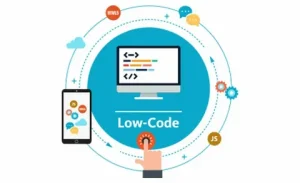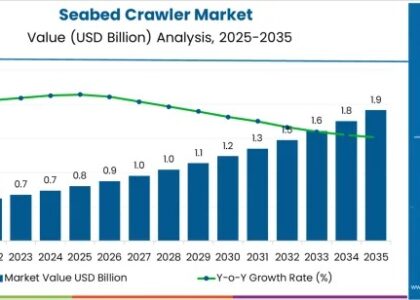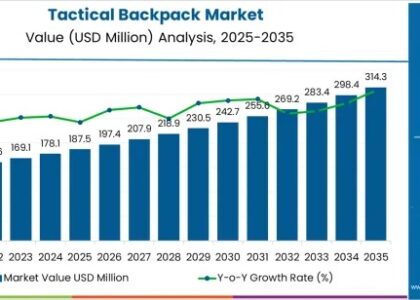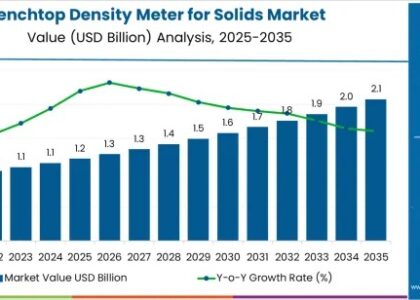
Low-code embedded analytics market enable businesses to integrate data visualizations, reports, and predictive analytics directly into their applications without the need for complex coding. This makes analytical tools more intuitive, faster to deploy, and easier for end-users to interact with, thereby enhancing business decision-making and operational efficiency. Analysts project that the global low-code embedded analytics market will be valued at USD 15,443.6 million in 2025 and is expected to surge to USD 44,247.7 million by 2035, registering a robust compound annual growth rate (CAGR) of 11.1% over the forecast period. This growth is driven by the accelerating digital transformation across industries, the widespread adoption of data-centric workflows, and the increased demand for user-friendly, real-time decision support tools that do not require advanced programming expertise.
The market’s momentum is supported by the rising need among enterprises to empower non-technical users with actionable insights embedded directly within enterprise software, ERP systems, CRM platforms, and other custom business applications. Low-code analytics platforms offer reusable components and drag-and-drop functionalities that drastically shorten development cycles and lower the cost of deploying sophisticated dashboards, KPIs, and predictive tools. As organizations in sectors like retail, healthcare, finance, and manufacturing prioritize data democratization and self-service analytics, the adoption of low-code embedded solutions is becoming a key strategic initiative to increase agility, transparency, and responsiveness. Furthermore, the emergence of AI-powered low-code platforms that automate data discovery and visualization is redefining how insights are generated and consumed across business units.
Elevate Your Strategy with Our Exclusive Report: Request Your Sample Now!
https://www.futuremarketinsights.com/reports/sample/rep-gb-17556
Key Takeaways
The low-code embedded analytics market is witnessing unprecedented growth and is expected to exceed USD 44.2 billion by 2035, reflecting a shift from traditional business intelligence models to seamless, embedded analytical experiences. Organizations are moving beyond standalone analytics platforms and opting for contextual, in-application insights that improve workflows, enhance user adoption, and increase time-to-value. This shift is not only enhancing productivity but also helping companies achieve a competitive edge by enabling faster, data-driven decisions. With modern enterprises striving for operational excellence and real-time business intelligence, low-code embedded analytics are emerging as essential building blocks of future-ready digital ecosystems.
Emerging Trends in the Global Market
A key trend shaping the global market is the integration of artificial intelligence (AI) and machine learning (ML) into low-code analytics platforms. These intelligent systems enhance the ability to generate predictions, automate data pattern recognition, and deliver personalized insights without extensive human intervention. The convergence of low-code development and AI is empowering even non-technical business users to access, interpret, and act on insights with minimal training. Another emerging trend is the focus on embedded analytics within mobile and web-based applications, allowing users to access real-time data dashboards and KPIs while on the move. This trend is being further amplified by the growth of remote work and decentralized decision-making structures in modern organizations.
Data governance and compliance are also influencing platform capabilities, with developers now offering features such as role-based access, audit trails, and GDPR/CCPA compliance modules integrated into low-code analytics frameworks. As data security and regulatory demands intensify, vendors are embedding privacy and security by design, ensuring their platforms are suitable for deployment in highly regulated sectors like healthcare, banking, and government. In addition, the growing popularity of open-source and API-driven platforms is fostering greater flexibility and customization, allowing developers to tailor embedded analytics to suit specific enterprise needs and integrate seamlessly with legacy infrastructure.
Significant Developments and Opportunities in the Global Sector
The rapid expansion of cloud-native and multi-tenant architectures is unlocking new opportunities for scalable embedded analytics deployments. SaaS providers are increasingly bundling analytics capabilities within their offerings, creating value-added solutions that differentiate their services in competitive markets. This “analytics-as-a-service” model is gaining traction across industries, allowing businesses to monetize their data and improve customer engagement through real-time, embedded insights. Similarly, embedded analytics are being leveraged in Internet of Things (IoT) environments to enable intelligent edge processing, where devices generate actionable insights from sensor data without requiring cloud round-trips, thereby improving latency and reliability.
Another area of significant development is the rise of vertical-specific analytics solutions. Vendors are creating low-code embedded analytics tailored for industries like logistics, retail, education, and public services, delivering domain-specific KPIs, predictive models, and workflows. These prebuilt templates and industry accelerators reduce deployment time, improve relevance, and enhance ROI. Moreover, partnerships between low-code platform providers and enterprise software vendors are on the rise, with joint go-to-market strategies aiming to provide embedded analytics as an integrated feature within existing enterprise systems, such as ERP, HRM, or supply chain platforms.
Recent Developments in the Market
Recent developments include the release of AI-augmented analytics capabilities by leading low-code providers, offering natural language query (NLQ), automated data storytelling, and augmented data preparation. These features enable users to ask questions in plain language and receive visual answers without requiring any SQL or coding knowledge. Cloud platform providers have also introduced analytics embedding toolkits and SDKs, allowing developers to seamlessly integrate dashboards into cloud-native applications while maintaining scalability and performance. Additionally, low-code platforms now offer customizable themes, responsive design capabilities, and accessibility compliance, ensuring that embedded analytics align with corporate branding and inclusivity goals.
Several vendors have expanded their ecosystems through marketplace integrations, enabling customers to access third-party data connectors, visualization widgets, and machine learning models that can be added to dashboards with minimal configuration. These marketplaces are simplifying the deployment of complex analytical environments and enabling innovation at scale. There has also been a surge in venture capital investment into low-code analytics startups, signaling investor confidence in the sector’s long-term growth potential.
Thorough Market Evaluation: Full Report
https://www.futuremarketinsights.com/reports/low-code-embedded-analytics-market
Competition Outlook
The low-code embedded analytics market is highly competitive, comprising a diverse mix of established business intelligence firms, low-code platform developers, cloud service providers, and emerging startups. Key players in the market include Microsoft Corporation (Power BI Embedded), Salesforce (Tableau Embedded Analytics), Qlik, Sisense, TIBCO Software, Zoho Corporation, Google (Looker), Domo Inc., ThoughtSpot, and Oracle Corporation. These players are focusing on expanding integration capabilities, enhancing AI-driven insights, and offering flexible licensing models to attract enterprise customers.
Key Segmentations
From a segmentation perspective, the market is divided based on deployment model (cloud-based and on-premise), organization size (small and medium-sized enterprises and large enterprises), application area (sales and marketing, finance, operations, HR, and others), and industry vertical (IT and telecom, healthcare, BFSI, retail, manufacturing, and government). Among these, the cloud-based segment holds the largest share due to its scalability and lower upfront cost, while the BFSI and retail sectors are leading in adoption due to their need for real-time performance tracking and customer behavior analysis.
About Future Market Insights (FMI)
Future Market Insights, Inc. (ESOMAR certified, recipient of the Stevie Award, and a member of the Greater New York Chamber of Commerce) offers profound insights into the driving factors that are boosting demand in the market. FMI stands as the leading global provider of market intelligence, advisory services, consulting, and events for the Packaging, Food and Beverage, Consumer Technology, Healthcare, Industrial, and Chemicals markets. With a vast team of 400 analysts worldwide, FMI provides global, regional, and local expertise on diverse domains and industry trends across more than 110 countries.
Contact Us:
Future Market Insights Inc.
Christiana Corporate, 200 Continental Drive,
Suite 401, Newark, Delaware – 19713, USA
T: +1-845-579-5705
For Sales Enquiries: sales@futuremarketinsights.com
Website: https://www.futuremarketinsights.com
LinkedIn| Twitter| Blogs | YouTube





